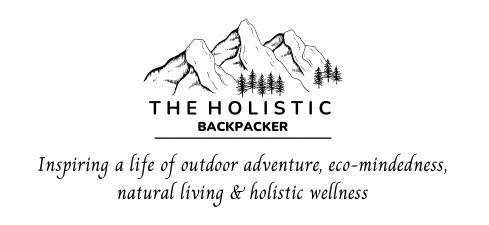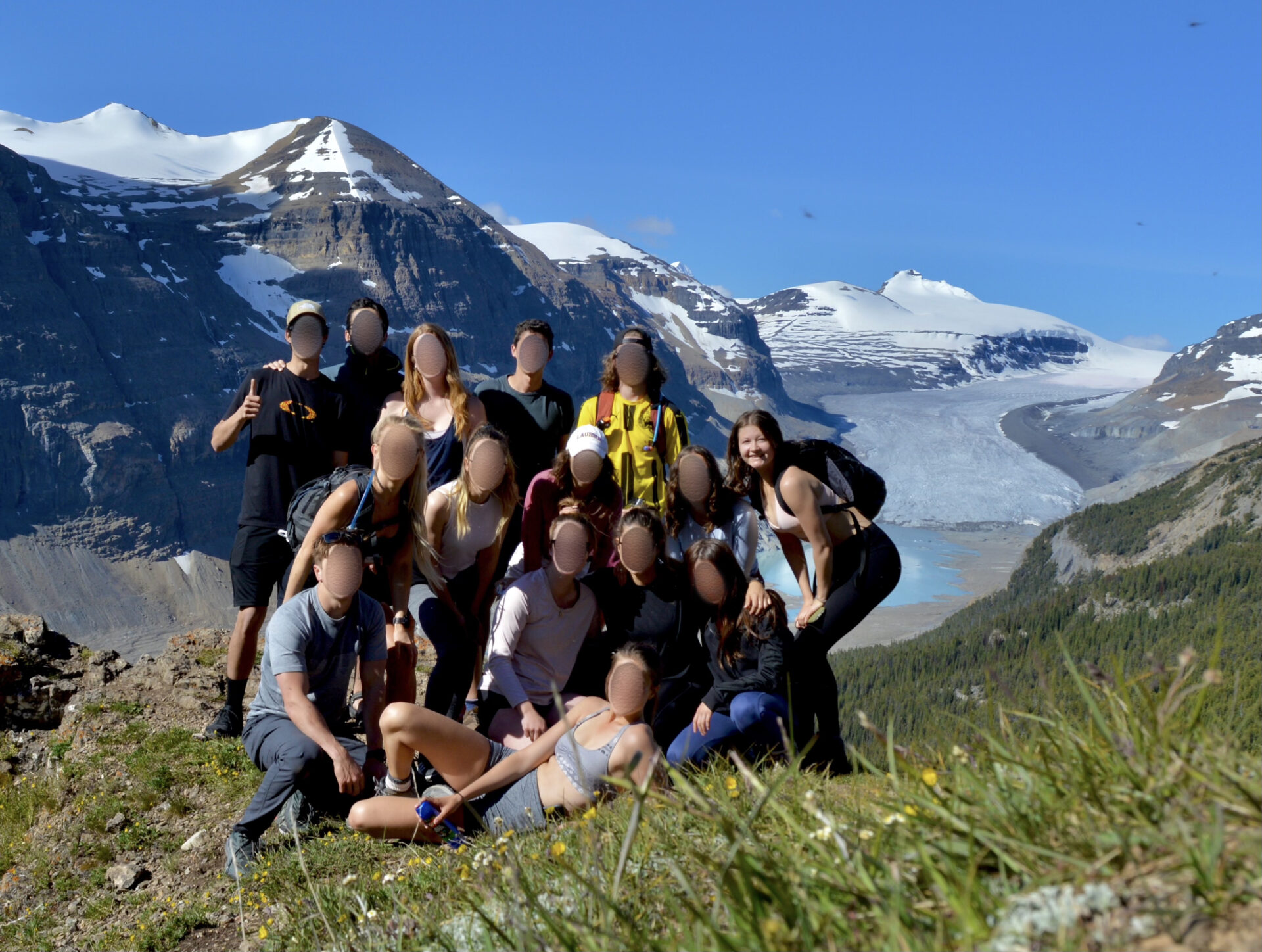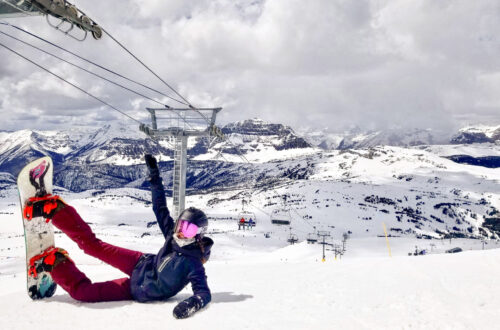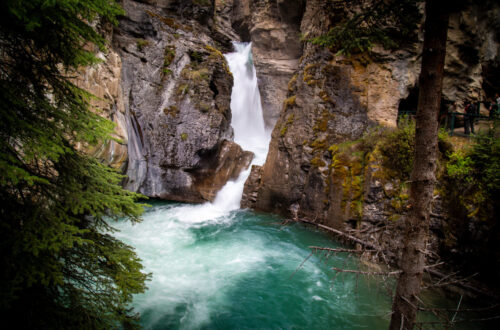
How to Plan a Trip to Banff: Backpacking to Luxury Travel
Planning a trip to Banff? You’ve come to the right place! This blog is full of information for those looking to plan a trip to Banff. From budget backpackers to luxury travellers this post has everything you need to know about exploring and backpacking Banff.
I’ve lived in Banff for years which has given me the chance to explore every nook and cranny of the park throughout every season – multiple times. I made this post as detailed as possible and included every tip I wish I’d known when I first moved here.
ps – download my Banff map to find every hike, hotel, restaurant, and viewpoint all marked in one place. I’ve loaded this map with my personal photos and descriptions.
how to backpack banff
Banff Google Map: 600+ Pins
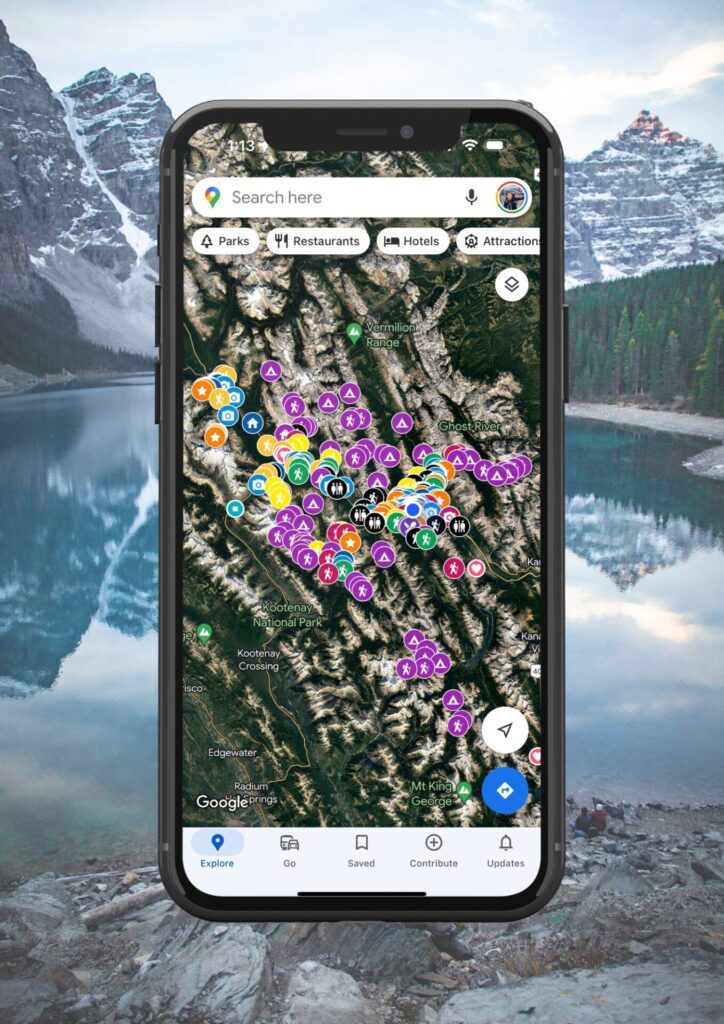
Get my 600+ Banff recommendations saved to your Google Maps app
Outdoors: 100+ hiking trails, backcountry campgrounds, ski resorts, waterfalls & lakes
Planning: lodging, restaurants, public washrooms & transit hubs
Things to do: tours, viewpoints & unique activities
I lived in Banff for years and know all the best spots!
You Must Plan your Trip to Banff in Advance
Before I get into the nitty-gritty details of this post, I want to make it crystal clear that you must plan your trip to Banff in advance. Shuttles, lodging, restaurants, activities, and just about everything else fills up entirely during the holidays and the summer season.
Banff is unfortunately not a place you can show up and “wing it.” Camping reservations must be made in January for summer. Hostels and popular hotels should be booked a couple months in advance (at least), and you should make reservations if you’re hoping to eat at particular restaurants if they have a happy hour, if its the summer, the holidays, or a weekend during shoulder season. Buses to Lake Louise and Moraine Lake should be made weeks/months in advance too.
how to backpack Banff on a budget.
Backpacking Banff: How to Budget Travel
In this post I’ve outlined all the ways to budget travel Banff. This is especially helpful for those looking to backpack Banff.
How to get to Banff
Banff is located in the Canadian Rocky Mountains within the province of Alberta. Conveniently, Banff is located only 1.5hrs from the city of Calgary – home to both the famous Calgary Stampede and the Calgary International Airport (YYC).

Most international travellers fly into the Calgary Airport, then take one of the following shuttles to Banff:
- BUDGET TRAVELLERS – On It and Poparide are the best options for those planning to backpack Banff as they offer the cheapest fare. On It’s schedule is seasonal and you need to book in advance to ensure you get a spot. Poparide is a ride share program. I’ve used it multiple times and have had good experiences. You can use my link to save $5 on your first trip.
- MID-RANGE TRAVELLERS – the Banff Airporter and the Brewster Express are both reliable and professional transportation services.
- LUXURY TRAVELLERS – taxis and Uber will cost you at least a couple hundred dollars one-way.
If you’re coming from Vancouver you can opt to fly to Calgary, drive, or take a bus. The most common bus company for Vancouver-Banff is Rider Express. This route typically takes 12-15hrs and makes stops in many places like Kamloops and Golden.
If your budget allows I recommend renting a car when you plan a trip to Banff – this site compares all the best local rates. Travelling Banff with a car allows you to access a much larger area of the park. If you’re a hiker this is important. Keep in mind if you rent a car you’ll need to purchase a National park Pass to display in your vehicle’s windshield for each day you’re in Banff. You can purchase these online or in person at the park gates and the visitor centre.
How to Get Around Banff
Canada is infamously horrible when it comes to public transportation outside big cities. Banff however has a great bus system for the local area. Popular spots like Canmore, Lake Louise, and Johnston Canyon can be reached by bus easily.

Much of the Icefields Parkway, Kananaskis, and a large area of Banff can only be accessed with a car. If you’re a hiker or like to get away from the “mainstream tourist spots,” I highly recommend renting a car to get around Banff. To recap – a Park’s Pass is required for vehicles and I recommend using this site to find the best local rental rates.
Banff and North America in general are best travelled to with a car. After living here for years I’d never recommend travelling Banff any other way.
For backpackers in Banff working with a smaller budget, make use of the local public transit system. Roam Transit currently has routes going to all the major tourist spots which does open up a large area of the park. Bus fees need to be paid in exact change when boarding, at the pay stations (which can be found here), or online via the Token Transit app. If you plan to use the bus frequently you can buy multi-use passes at the visitor centre for a cheaper rate.
If you plan a trip to Banff in winter each ski resort in Banff has a free shuttle.
I won’t go into too much detail about Banff’s local transportation system here as I’ve written this post which outlines everything you need to know about Banff’s public transportation system as well as 50+ hikes you can access in Banff and Canmore using the bus.
How to get to Moraine Lake and Lake Louise
Whether you’re backpacking Banff or planning a luxurious trip to the mountains, Moraine Lake and Lake Louise are at the top of everyone’s bucket list.
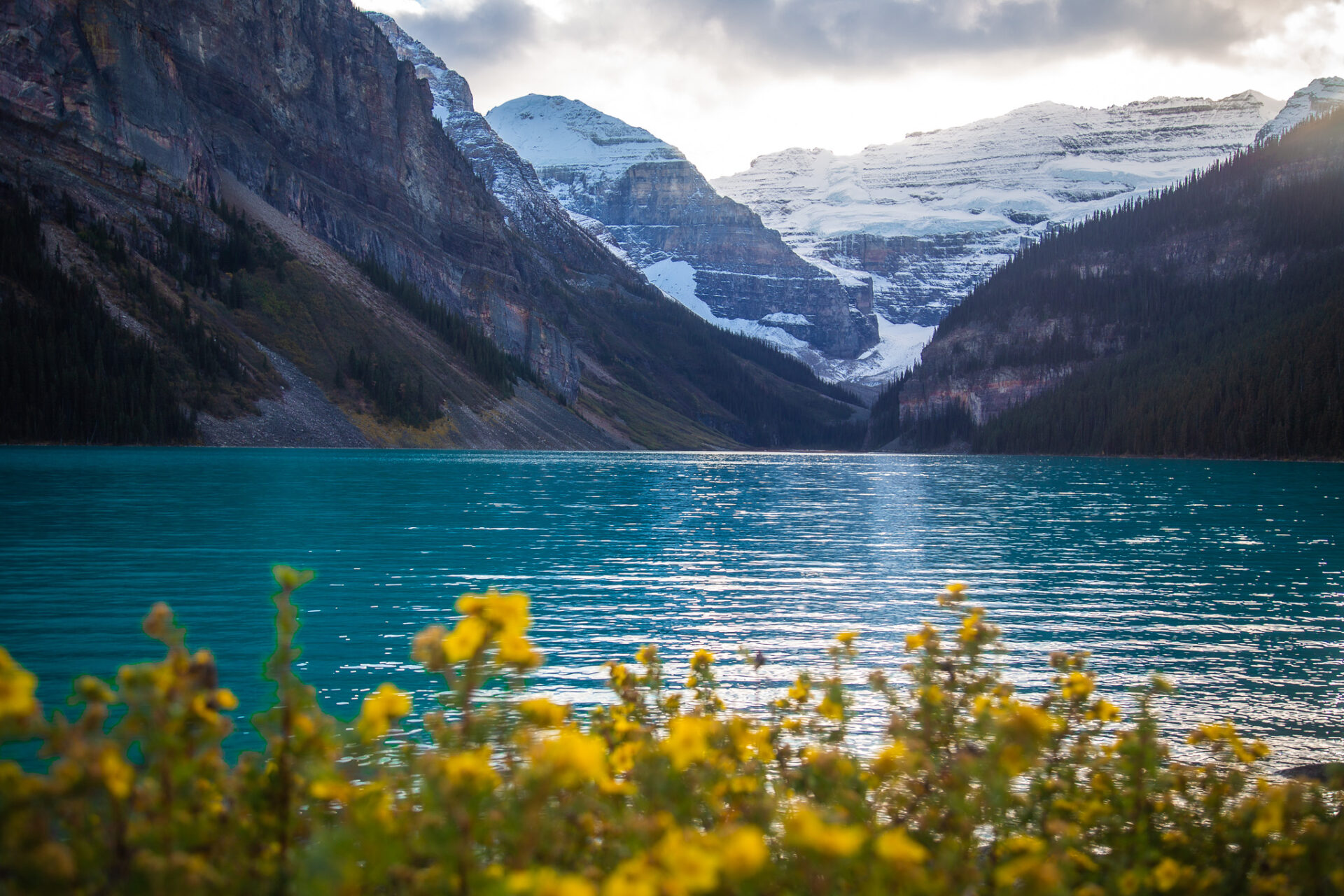
As of 2023 new road restrictions were put in place making it impossible to drive a personal vehicles to Moraine Lake. Lake Louise has high parking fees and limited parking spaces making it difficult to visit both these lakes. Planning ahead is a MUST.
The best way to access Moraine Lake and Lake Louise is 100% by using public transportation and in this post I go into detail regarding everything you need to know about routes, fees, parking, and more.
If you’d like to see Moraine Lake at sunrise, you must book a tour in advance.
Planning a trip to Banff can be easy.
Best Time of Year to Visit Banff
Each month of the year offers something unique in Banff. There’s not a “best” time of year to plan a trip to Banff – it just depends on what you’re hoping to experience.
In this guide I’ve broken down each month in Banff month-by-month
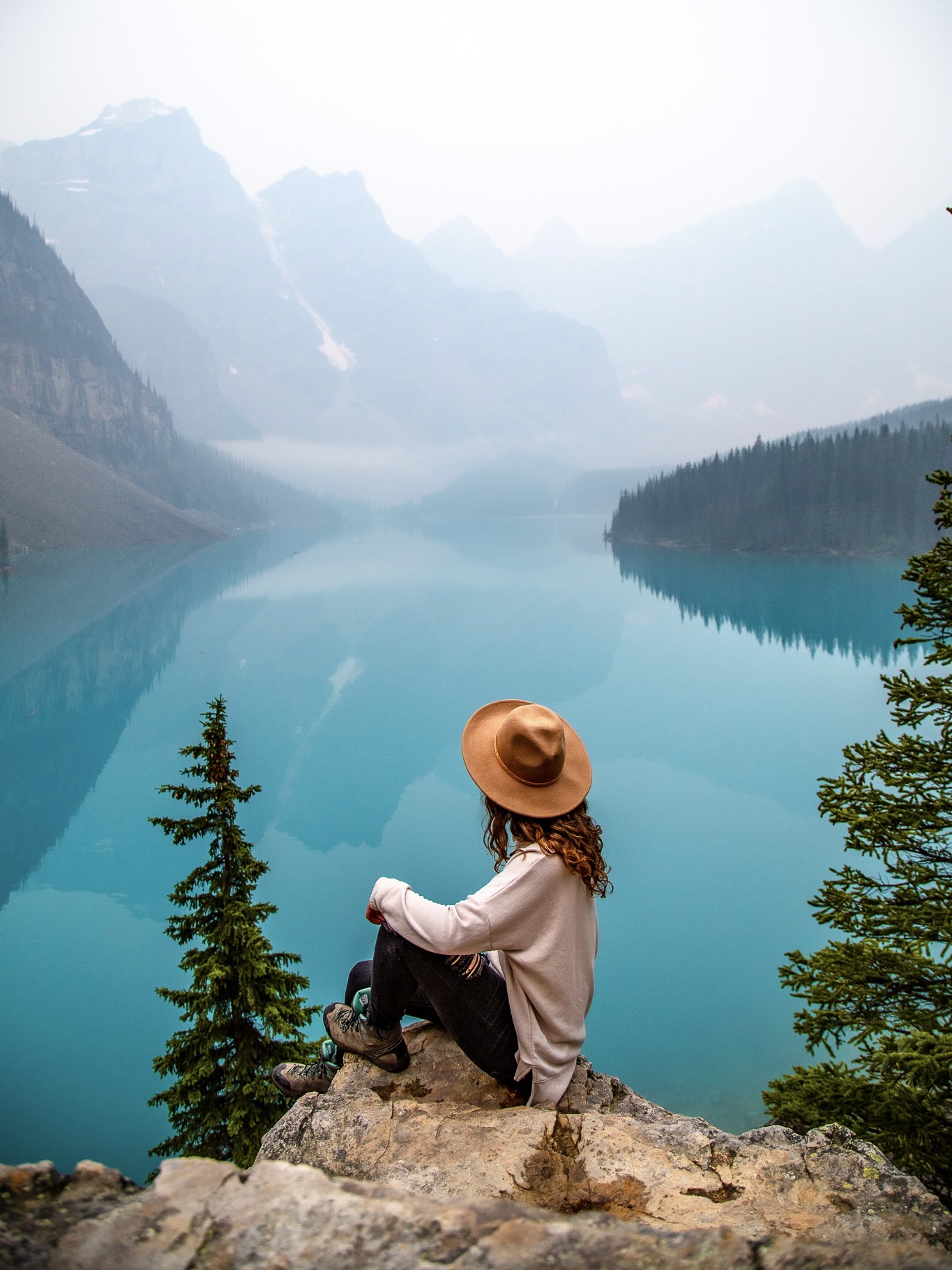
Banff sees 4 “seasons” each year, however I like to think of them more as summer, almost winter, winter, and late winter. It’s not uncommon to see the first snowfall in September with the last being in June or July the following year.
I’d like to preface any mention of winter and snow below with warnings of avalanche danger. As soon as snow starts falling in Banff there’s potential for avalanches.
Without getting too science-y, due to Banff’s location, terrain, and local weather patterns avalanche risk here is greater than elsewhere in Canada. If you’re going out hiking or skiing the backcountry, PLEASE check the avalanche bulletin, take an avalanche course, bring proper gear, and make sure you’re not entering avalanche terrain unaware. The visitor centre in town can provide more information about avalanches.
Summer in Banff

July and August are the best months to plan a trip to Banff for warm weather, water activities, camping, and hiking as most local summits lose snow by then. Mid August is the best time to attempt any major summit near the 3,000m mark whereas mid July onwards is best for wildflowers as they start to bloom at elevation at this time.
Keep in mind as time progresses Canada is seeing more and more wildfires. July and August are the most intense months for smoke which can be harmful to your lungs and make any of the activities mentioned here unenjoyable. Think no views, burning eye/lungs, and all the other fun physical symptoms that come with fire season.
Summer is when all the bus routes run in full capacity and tourism is at its peak. Aside from the high season prices, summer is the best time for backpackers in Banff, especially if you’re visiting without a car.
Can you backpack Banff in winter?
Autumn in Banff
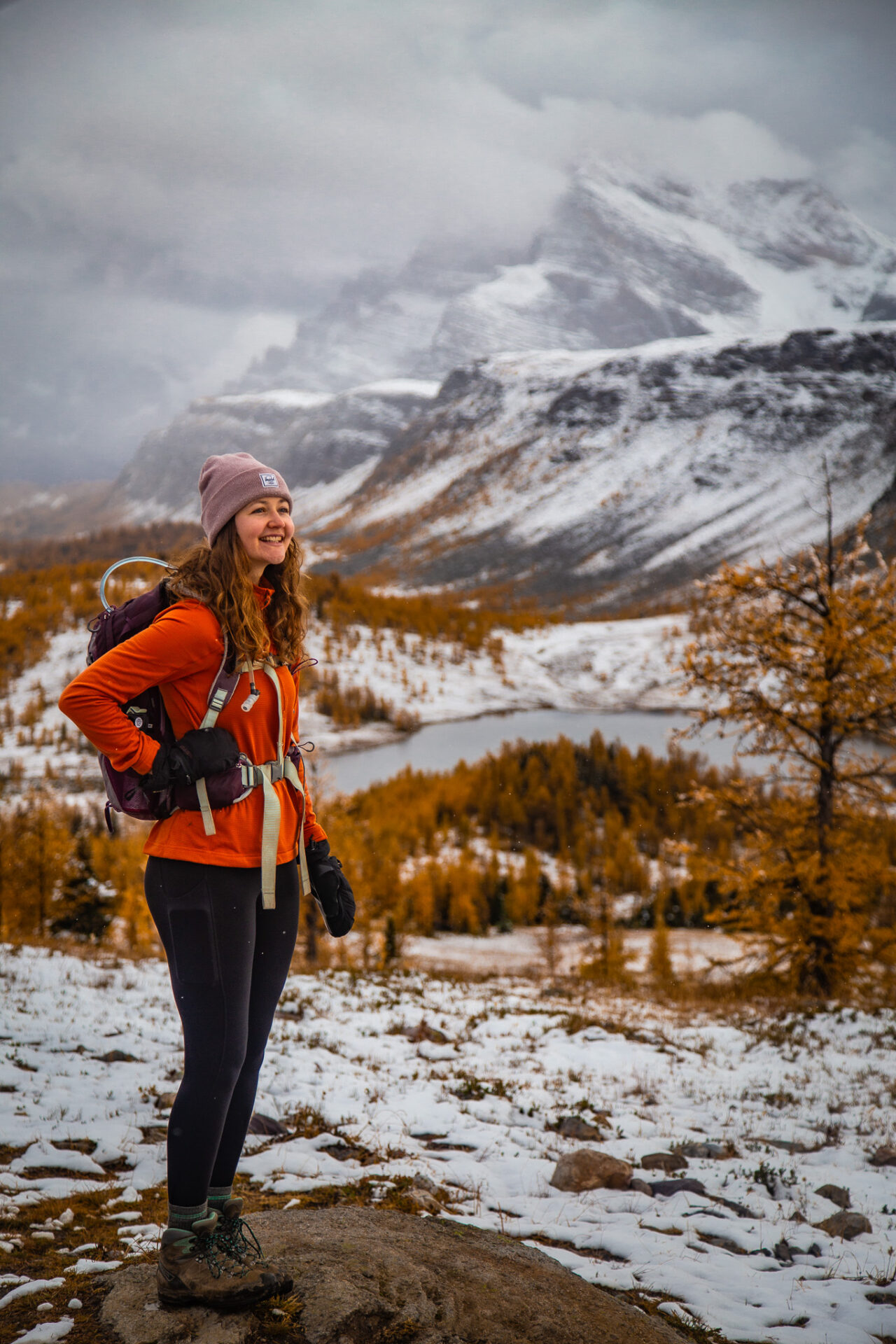
September is generally a nice time to plan a trip to Banff and most activities mentioned above can be completed unless the snow starts falling early. Some years late September is warm enough for camping, other years there’s already snow in the mountains meaning hiking season (for summits) wraps up early.
October is Larch season. This means you’ll see many trees in the area turning bright yellow. Usually the peak of Larch season hits around the first week of October, but this can vary due to how warm/cold September is. By mid October the Larch trees loose their needles, shoulder season pricing is in effect, snow starts falling regularly, and skies are usually grey.
Many of the public bus routes stop after Larch season is complete. If you’re planning a trip to Banff after the first week of October, chances are you’ll want to rent a car.
Snowfall and grey skies continue during the month of November which I would say is arguably the worst month to plan a trip to Banff. November does have a couple positives though – it’s the quietest month tourist-wise, lower shoulder season prices for dining and accommodations are in effect, and if you time it right toward the end of the month you can see snowcapped mountain peaks and frosty trees next to the bright blue lakes before they freeze over. The ski resorts also open partially toward the end of the first week of the month.
Winter in Banff
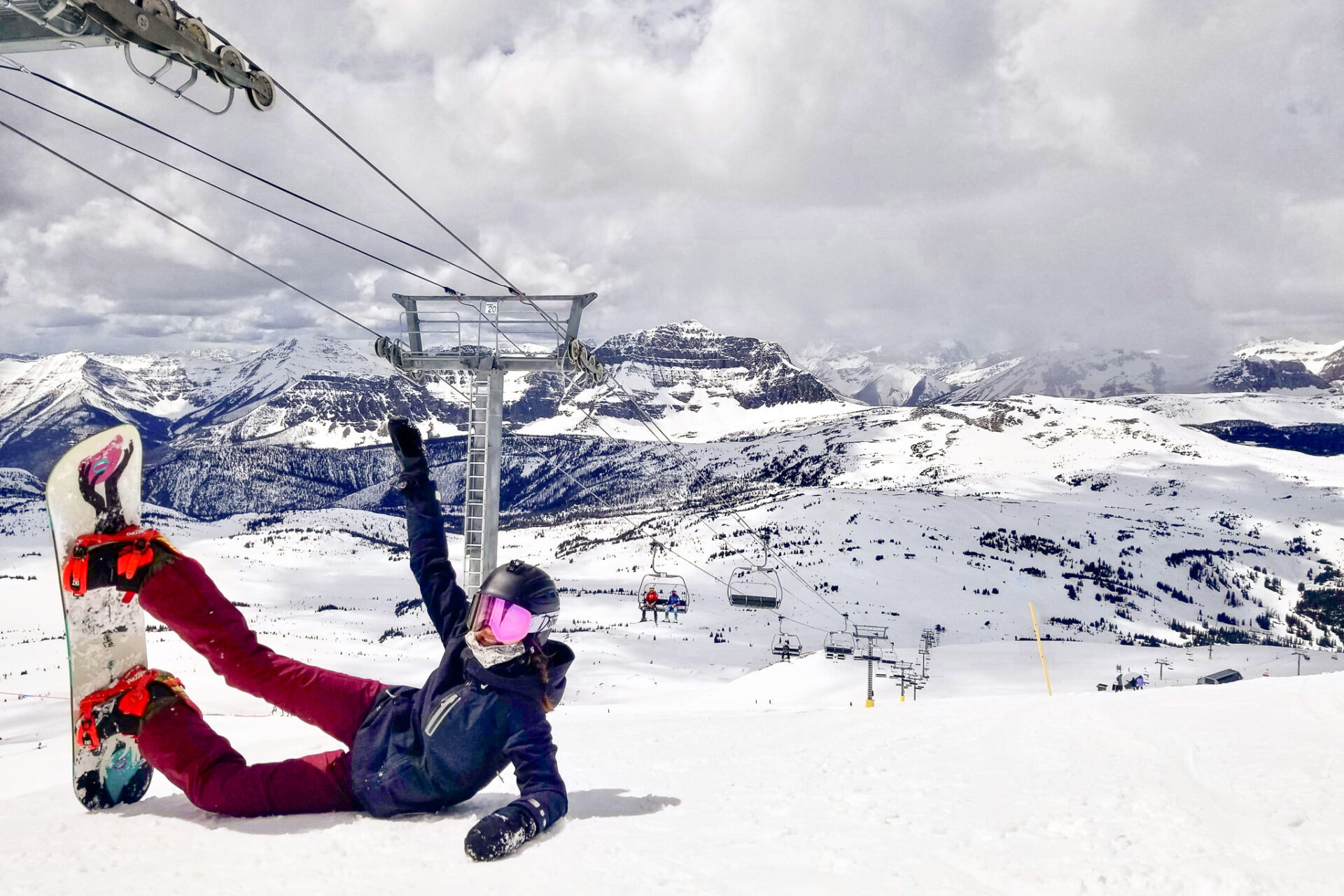
Ski season starts early November, but doesn’t necessarily get good until late December/early January some years. Early December is usually when the lakes start freezing and the holiday magic starts. December is the best month for wild ice skating in the Rockies.
January and February are the coldest months in Banff. This is when you’ll have the best snow conditions for skiing, great snowshoeing opportunities, and the frozen waterfalls are at their peak size. Don’t be surprised if temperatures reach -40 degrees (C/F) during this time. Each winter for about a week near the end of January/early February it gets so cold the ski resorts shut down and boiling water freezes mid air.
How to plan a trip to Banff for first time visitors.
Spring in Banff

March to May is getting into the spring season. Temperatures don’t really begin to noticeably warm up until May, but the skies will generally become bluer and spring skiing late April/early May is ideal. April in Banff is notorious for warm temperatures, sunny skies and fresh pow.
There’s still too much snow to do any major hiking in May, but generally every hike mentioned in this post will not put you at risk for avalanches.
Late May to April is also the best time of year to see waterfalls in and around Banff as the snowmelt is at its peak. You’ll also likely see more wildlife during this time before the summer crowds arrive.
Banff Google Map: 600+ Pins

Get my 600+ Banff recommendations saved to your Google Maps app
Outdoors: 100+ hiking trails, backcountry campgrounds, ski resorts, waterfalls & lakes
Planning: lodging, restaurants, public washrooms & transit hubs
Things to do: tours, viewpoints & unique activities
I lived in Banff for years and know all the best spots!
What to Pack for Banff
What to pack for your trip to Banff totally varies depending on what activities you plan to do and what time of year you visit. The best advice I can give you is to dress in layers and pack clothing made of natural materials.
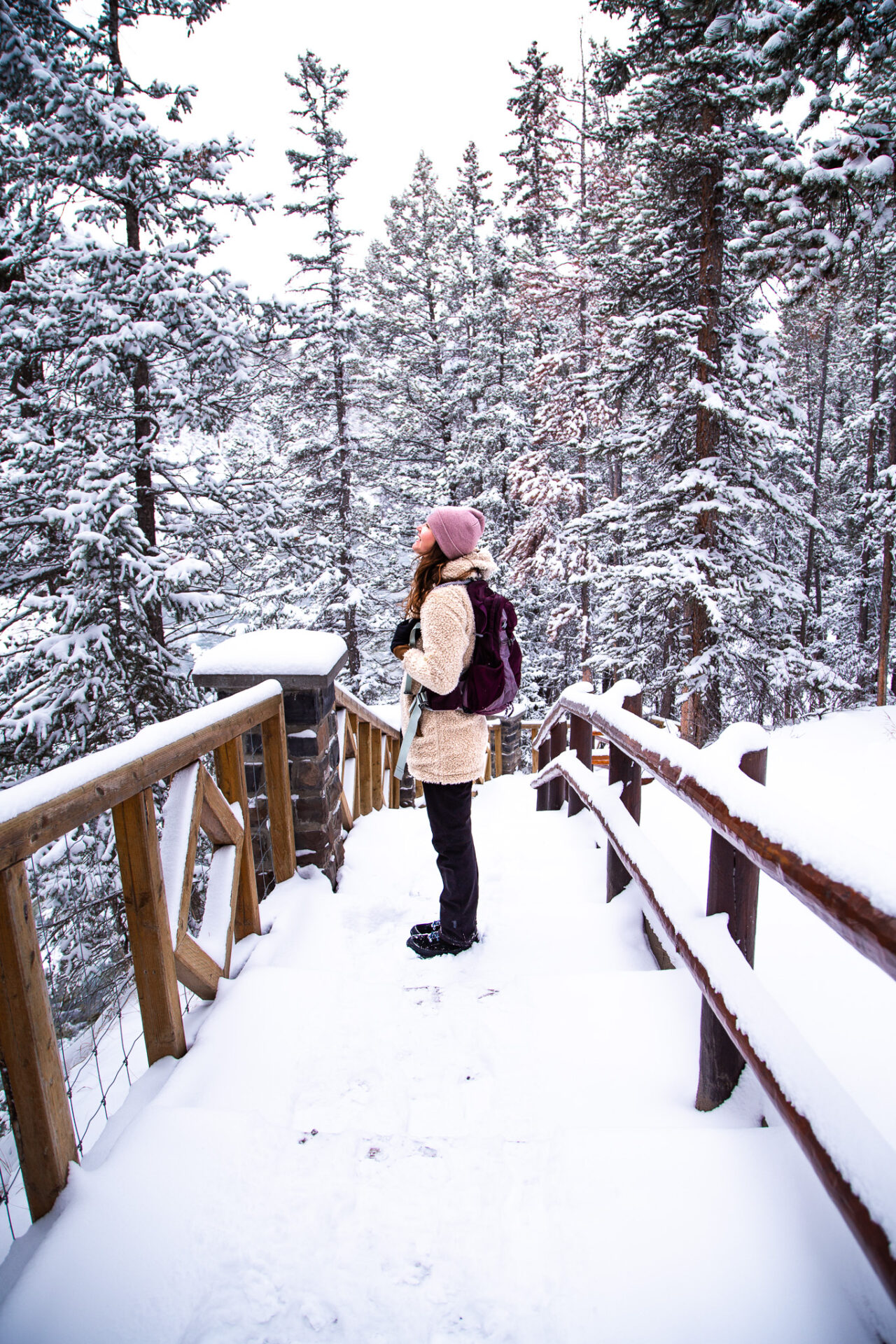
Banff is an outdoorsy destination which means you can leave the high heels and “going out” clothes at home, unless you in fact plan to go clubbing here. The outdoorsy look is the everyday style here, so you could wander into a club wearing hiking pants and a beanie and no one would look at you funny.
Generally you’ll want to pack athletic clothing for your trip to Banff. As someone who lived in Banff my daily uniform was hiking pants, hiking boots or trail runners, base layers, waterproof jackets, down coats, and wool sweaters – no matter if I was on a hike or going to the grocery store.
What to Pack for Each Season in Banff
If you plan a trip to Banff in winter pack warm not “cute.” Wool base layers, multiple pairs of wool socks, a down jacket, insulated pants, insulated winter boots, multiple pairs of hats and gloves, neck warmer/scarf, and these reusable hand and foot warmers – I use these daily for walking around town or skiing. I swear by them. If you bring any “cute” outfits, make sure you can walk outside in the outfit in -20. If you’re skiing bring a full ski setup in addition to what I already mentioned.
If you plan a trip to Banff in autumn or spring, you don’t need to bring any summer clothing. Typically temperatures are cold enough to require pants, jackets, and gloves at almost all times. Only on odd years is it warm enough for shorts or T shirts during spring or autumn. Hiking boots, down coats, and waterproof jacket + pants are a must. Essentially pack to be warm and functional with an emphasis on layers.
If you plan a trip to Banff in summer you’ll need to pack a bit of everything. Summer clothing and bathing suits to waterproof layers and pants. On the same day in July I often find myself wearing a down jacket, hat and gloves on a summit hike, then coming down the mountain for a lake swim in my bikini.
This guide has my favourite clothing items for Banff
Banff backpacker community is strong.
Where to Stay in Banff
From hostels to camping to luxury hotels – Banff has accommodations for everyone. Here are my top recommendations for where to lodge in Banff based on every budget.
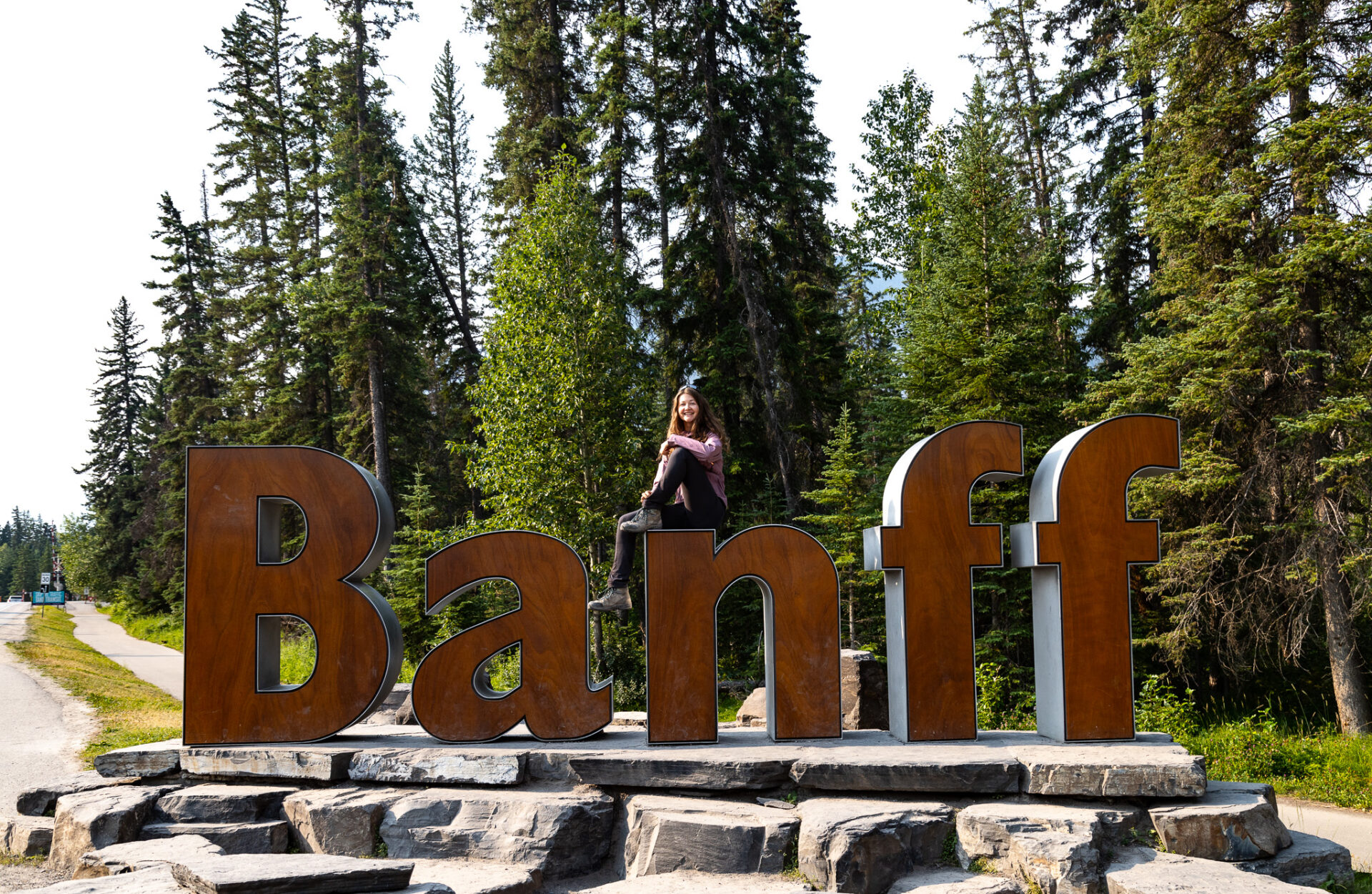
I recommend giving this post a read as I’ve listed every Banff hotel worth staying at and organized them by category.
- Hostels – Samesun Banff (best location + bar/restaurant on-site), Banff International Hostel (second best), and HI Banff.
- Budget hotels – Bow View Lodge and High Country Inn.
- Mid-range stays – Banff Park Lodge, Mount Royal, Elk & Avenue, and the Banff Caribou & spa.
- Luxury stays – Fairmont Banff Springs and the Rimrock Resort.
- Cabin retreats: Johnston Canyon Bungalows, Baker Creek, and Castle Mountain Chalets.
- Camping – reservation information can be found here. Ensure you book campsites far in advance as they’re full during summer.
- For those on ski trips: lodge on-mountain at Sunshine Village, stay near Norquay, and see my Lake Louise suggestions below.
Lodging Options Near Banff
Enjoy the nature and activities of Banff National Park, but lodge away from the busy tourist town centre at any of the following:
- Lake Louise – Fairmont Chateau Lake Louise (luxury), Paradise Lodge & Bungalows (500m from the lake), Lake Louise Inn (value stay), HI Lake Louise (hostel).
- Canmore – Malcolm Hotel (luxury), Stoneridge Mountain Resort (condo suites with fully equipped kitchens), Mountain View Inn (budget), Canmore Downtown Hostel & the Canmore Hostel (party hostel).
- Johnston Canyon – Johnston Canyon Lodge & Bungalows, Castle Mountain Chalets, and HI Castle Mountain Hostel.
- Yoho National Park – Emerald Lake Lodge and Cathedral Mountain Lodge.
- Kootenay National Park – Storm Mountain Lodge & Cabins.
- Kananaskis Country – Mount Engadine Lodge and Kananaskis Mountain Lodge (luxury), Crosswaters Resort (mid-range), and HI Kananaskis Wilderness Hostel (budget).
Top Tours & Excursions in Banff
Banff Gondola – epic views from the top of Sulphur Mountain.
Banff Hop on Hop off – explore the park at your own pace.
Lake Minnewanka Cruise – take a scenic boat ride down the largest lake in Banff.
Moraine Lake sunrise – chartered bus to see alpenglow on Canada’s most beautiful lake.
Norquay via ferrata – epic beginner friendly climbing route across iron bars on Mt Norquay.
Sunshine Meadows Gondola – find wild alpine flowers and hike around pristine alpine lakes.
Click here for a complete list of the Banff tours I recommend:
Free & Cheap Activities to do in Banff
Aside from the tours I outlined above, there are plenty of free – or near free – activities to do in Banff. Those backpacking Banff will want to make the most of these free Banff activities as local tours can be pricey.
ps – I marked every activity mentioned below on my Banff & Lake Louise Map.

Go to the lake – Lake Minnewanka, Two Jack Lake, Cascade Ponds, and Johnson Lake are all accessible by public transit. Johnson Lake is the warmest for swimming.
Visit the local museums – there are 4 museums in town, each offering a cheap fee to enter. Cave & Basin has natural hot springs, Buffalo Nations is about Indigenous Peoples, Banff Park Museum is all about the local wildlife, and the Whyte Museum tells Banff’s origin story.
Have a bonfire – Cascade Ponds and the Banff Recreation Grounds have Parks Canada public fire pits – outside the Parks Canada fire pit bonfires are illegal. Wood for burning must be purchased at the local gas stations – no outside wood permitted in the park.
Watch sunrise/sunset – my favourite spot is at the top of a mountain. Aside from this anywhere downtown by the river in Banff is nice and Surprise Corner is great for sunrise. Two Jack Lake, Norquay Patch, Vermillion Lakes, and the Hoodoos Lookout are my favourites for sunset.
Banff Google Map: 600+ Pins

Get my 600+ Banff recommendations saved to your Google Maps app
Outdoors: 100+ hiking trails, backcountry campgrounds, ski resorts, waterfalls & lakes
Planning: lodging, restaurants, public washrooms & transit hubs
Things to do: tours, viewpoints & unique activities
I lived in Banff for years and know all the best spots!
Go for a drive – if you opt to rent a car you can drive the Icefields Parkway, to Kananaskis Country, or to other nearby National Parks like Yoho and Kootenay.
Go biking – mountain, road, and e-bike rentals are readily available in many shops in Banff like Bactrax and Banff Cycle. The 1A to Johnson Canyon, the Legacy Trail (from Banff to Canmore), Vermillion Lakes road, the Lake Minnewanka Loop, and the Banff Springs Golf Course Loop are all popular biking routes in/near town.
Rent canoes – canoe rentals are available at the Banff Canoe Club for a decent hourly rate.
Hot Springs – go for a dip in Banff natural hot springs. My favourite time to visit the Banff Hot Springs is after a big hike, big day of skiing, or during odd times of the day in winter when they’re quiet.
Explore the town – Banff Ave is full of shops and restaurants. There’s also a walking trail next to the river in town that goes to Bow Falls.
Go hiking – more about this below.
For more detailed suggestions regarding things to do in Banff, you can check out my other posts:
50+ things to do in Banff in summer
30+ things to do in Banff in winter
Hiking in Banff
Banff is a mecca for hiking and backpacking. There are endless trails and backcountry campgrounds to explore, plus trails for every type of hiker regardless of their age or past hiking experience.
ps – I marked every hike mentioned below on my Banff & Lake Louise Map.
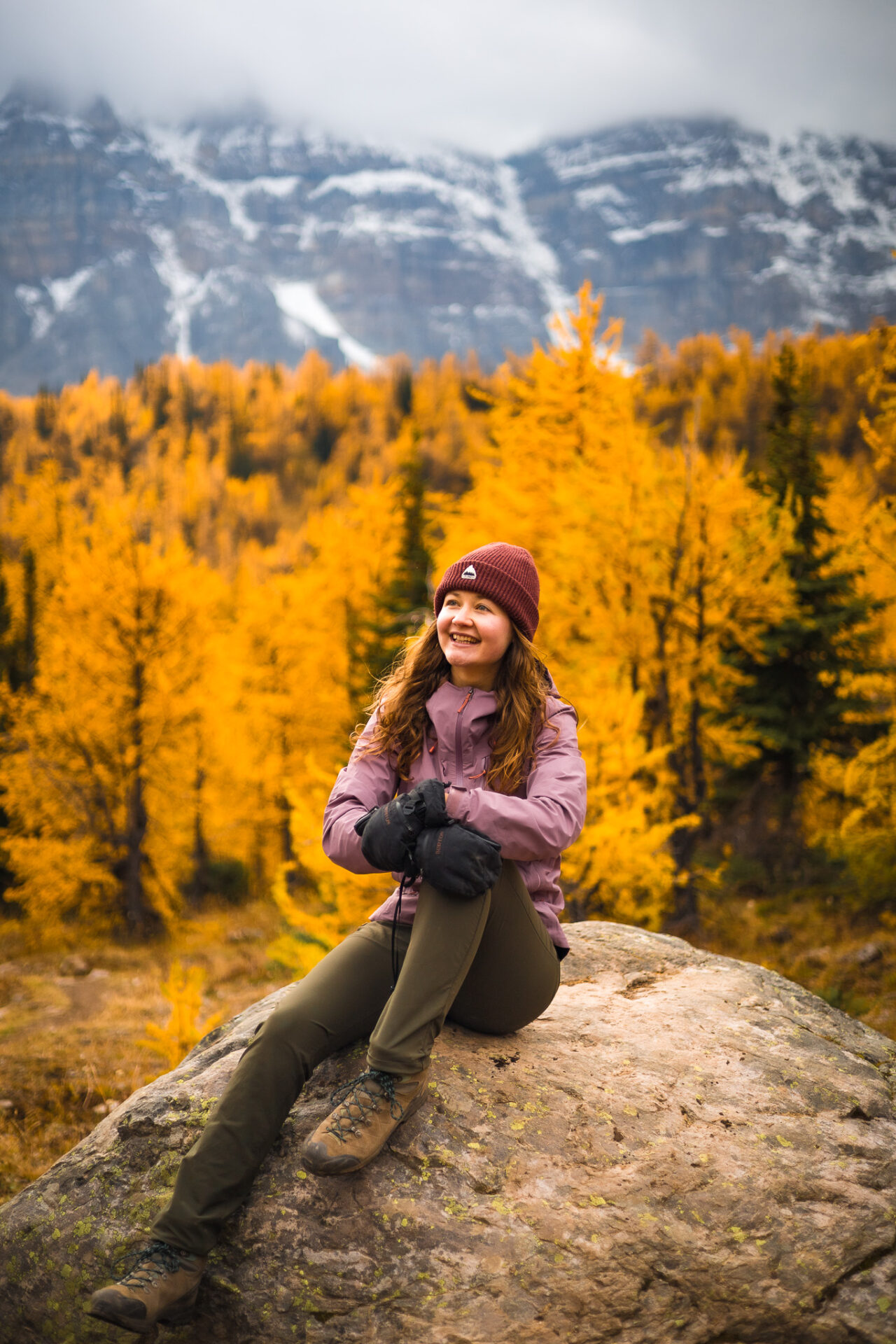
Banff Hikes Accessible by Bus – can all be found in this post.
Easy Hikes in Banff – I’ve listed them all in this post. These hikes can all be completed in winter with low to no avalanche risk. Most of them are accessible by bus too.
Lake Louise & Moraine Lake Hikes – here’s every hike at Lake Louise and every hike at Moraine Lake (front country and backcountry). These hikes are all accessible by bus for the backpackers in Banff.
Lake Minnewanka Hikes – can all be found in this post, including the backcountry route to Ghost Lakes.
Popular Tourist Hikes – Tunnel Mountain, Sulphur Mountain, Ha Ling (in Canmore), Lake Agnes, and Johnston Canyon.
Backcountry Hikes in Banff – Skoki Loop, Glacier Lake, and Taylor Lake are great for beginners.
Every Banff trail guide I’ve written can be found on this page.
Banff backpacker community.
Tips for hiking in the Canadian Rockies:
- Initially take a conservative approach to get used to altitude, elevation gain, and rocky terrain.
- Weather changes on a dime. Always bring extra layers, snacks, and water – even in summer.
- Carry a satellite device in case something goes wrong (most areas in Banff don’t have cell service). I always carry this device no matter what trail I’m on.
- Carry bear spray – you can buy this at local shops like Monod’s – know how to use it.
- Hiking boots are better for rocky terrain above the treeline – I love this pair (men’s version). Trail runners or running shoes can be used for anything low elevation or deemed “easy.”
- Use a hydration bladder to carry your water and stay hydrated. I like this 3L bag.
- Hiking poles aren’t “just for old people” (as my European friends like to say). Everyone uses poles here and they’re super helpful.
- A proper backpack with waist and hip straps is helpful. I like this bag (men’s version) and have been using it for years. I also purchased this bag (men’s version) for longer hikes, quick overnighters, and winter hiking.
Here are a few helpful guides I’ve put together:
- What to Wear Hiking in Banff
- What to Bring on a Day Hike in Banff
- Gear Guide for Camping Trips in Banff’s Backcountry
These are helpful resources for anyone looking to plan a backpacking trip to Banff.
Winter Activities in Banff
From November to March Banff morphs into a winter wonderland full of ice sculptures, snowy peaks, and frozen lakes. Those planning to backpack Banff can still do so in winter, but advanced planning is mandatory.
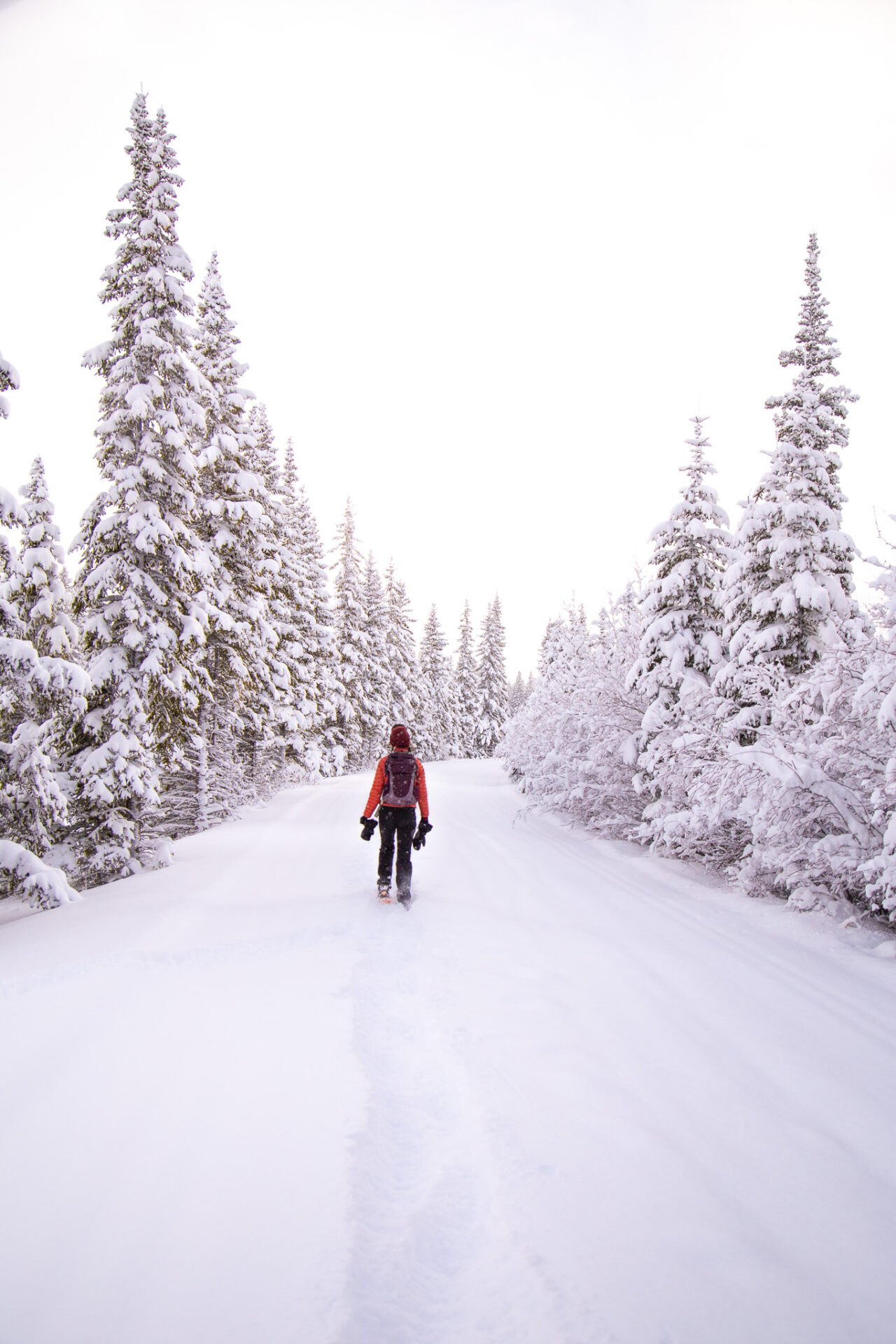
Here’s my guide to winter in Banff with 30+ things to do
Skiing – there are 3 ski resorts in Banff coined SkiBig3; Banff Sunshine Village, Lake Louise Ski Resort, and Norquay. Ski season in Banff lasts from November to May with the peak months being Jan/Feb for the most snow, and late April/early May for spring skiing.
- My Local’s Guide to Skiing Sunshine Village
- Which Banff Ski Resort is Best? SkiBig3 Breakdown
- What It’s Like to Work at Sunshine Village
Frozen Waterfalls – peak in late January/early February. Cascade Falls, Tessa Falls, and Silverton Falls exist near the town of Banff. Panther Falls along the Icefields Parkway is my favourite. There’s also the Green Monster and Troll Falls in Kananaskis and the Natural Bridge in Yoho.
Skating – the town of Banff opens skating rinks in the winter, but December is when the lakes freeze over and you can try wild ice skating before the snow covers their surfaces. Abraham Lake, which is about 2hrs from Banff, is famous for frozen methane bubbles however there are many local lakes you can skate on too. PLEASE do your research before wild ice skating as it comes with many risks.
Snowshoeing – is best completed after a fresh snowfall. Many snowshoeing routes in Banff are popular which means they get tracked out quickly.
Fat biking and xc skiing – equipment can be rented out at many shops in town – my go-to is always Bactrax. The employees can point you in the right direction of where to go.
how to plan a trip to Banff.
Best Restaurants in Banff
Banff has oodles of restaurants ranging from takeout to fine dining. For a mountain town there’s also a surprising amount of international dishes available too.
Those backpacking Banff or anyone planning a trip to Banff on a budget should make use of Taxi Mike. Taxi Mike is run by a local who keeps up with all the Banff restaurant’s happy hours, meal deals, and drink specials.
Best Breakfast in Banff: Juniper Bistro, Wildflour Bakery, and Tooloulous.
Best Takeout in Banff: Tim Hortons, Subway, Hankki (Korean), Dominoes, BarBURRITO, Pizza Pizza, and Aardvarks (open late).
Tastiest Sweat Treats in Banff: Cows (ice cream), Beaver Tails (Canadian specialty), gelato from Little Wild, and the Fudgery.
Popular Casual Dining Spots in Banff: Earl’s, Eddie Burger, Three Bears (said to be the best restaurant in Banff), and Maclab Bistro (great view and decent prices).
Vegetarian Restaurants in Banff: Nourish and Maclab have great vegetarian/vegan options.
Fine Dining in Banff: Sky Bistro at the Banff Gondola, The Keg Steakhouse, The Brazen, The Vermillion Room, and The Maple Leaf.
Best Pizza in Banff: Bear Street Tavern.
Best Bars/Pubs in Banff: High Rollers (bowling, pool, and dance floor), Park Distillery, Earl’s, Rose & Crown (great rooftop patio), The Dancing Sasquatch (nightclub), Elk & Oarsmen, and Mel’s (local favourite).
Best International Restaurants in Banff: Greek; The Balkan. Japanese; Shoku Izakaya, Ramen Aarashi, and Hello Sunshine (karaoke). Mexican; Anejo and Magpie & Stump. Indian; Masala, Saffron, Indian Curry House. Italian; LUPO (best pasta), Pacini, La Terrazza, Ticino (Swiss/Italian).
Family Dining in Banff: Boston Pizza and The Old Spaghetti Factory.
backpacking Banff and how to plan a trip to Banff.
Tips to Save Money in Banff
Banff is an expensive place to travel. Regardless if you make use of the tips below or not, you’ll still pay top dollar if you’re backpacking Banff or travelling in luxury.
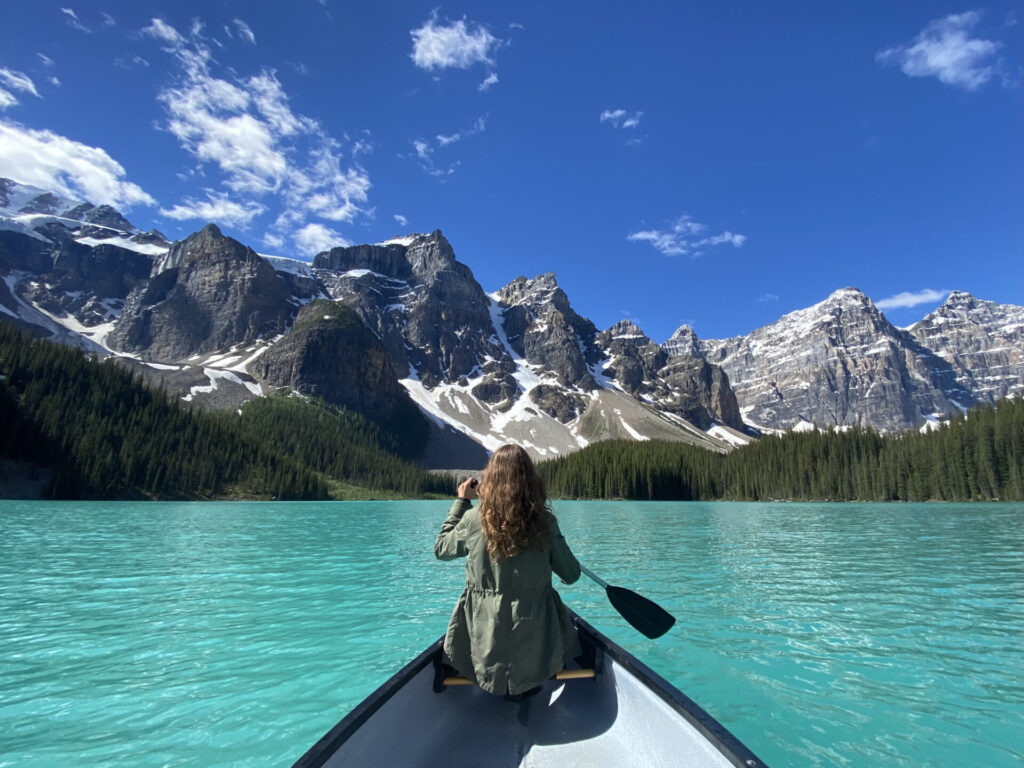
Here’s my complete guide to budget travel Banff
- Cook “at home.” There’s an IGA and Nesters for grocery stores in town, but nearby Canmore has larger grocery stores like Save On. Try to cook as much as possible at home rather than eat out at the pricey restaurants here.
- Avoid drinking. Nothing runs up a vacation bill quite like alcohol.
- If you do opt to go out for a meal or drink, make use of Taxi Mike to find all the best meal deals, happy hours, and drink specials.
- For the best rates on accommodations travel in groups of 4 and stay at the campgrounds (BYO tent). If you stay in the campground, reservations should be made in January when reservation day launches (exact dates for reservation day vary year-by-year).
- Take advantage of the (nearly) free activities I mentioned above.
- Travel in the shoulder season for cheaper prices. Mid October to the end of November is good for this.
- Opt to lodge in Canmore rather than Banff. Canmore is becoming more and more expensive as the years go on – it’s referred to as “the next Banff” – however for now some establishments offer a price break.
Wondering how to plan a trip to Banff? Here’s everything you need to know.
Destinations Near Banff
When planning a trip to Banff, many people opt to add a few destinations onto their itinerary as there’s many other national parks and beautiful places in the surrounding area. Unfortunately this is not possible for those backpacking Banff on a budget as visiting other destinations requires a car.
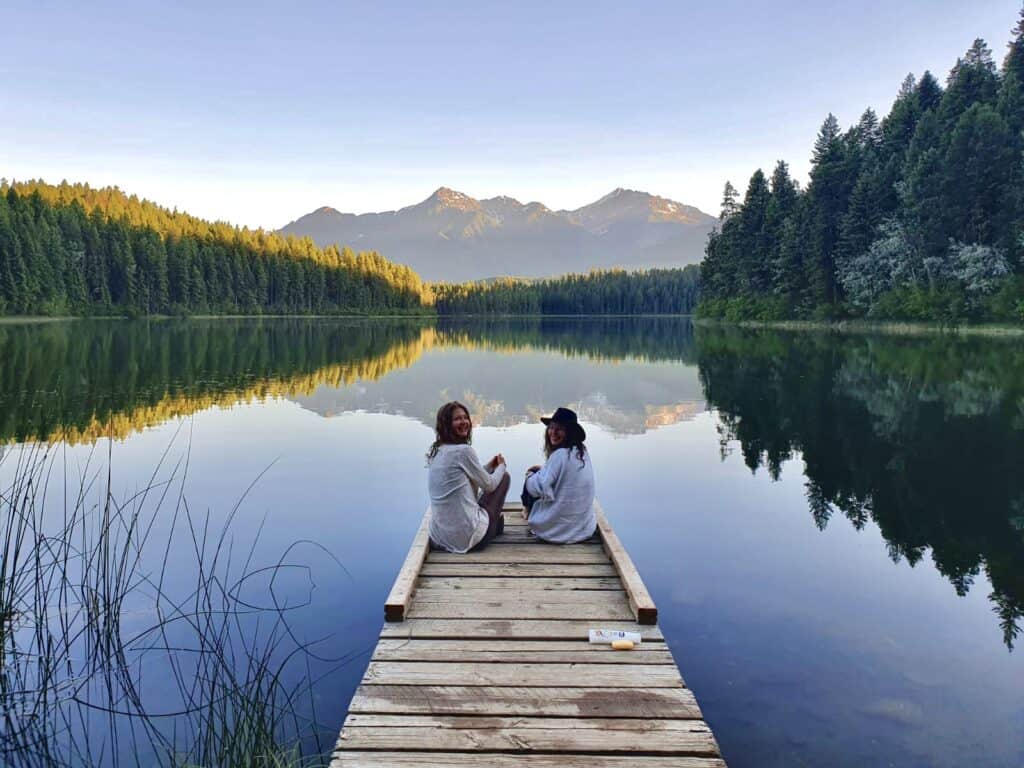
Banff is just a quick drive away from Alberta’s neighbouring province, British Columbia. Kootenay National Park and Yoho National Park are just a stone’s throw away.

Kananaskis Country is located approx. 40 minutes away and has incredible hiking trails, mountains, and lakes. I often opt to hike in Kananaskis over Banff as there are so many trails here.
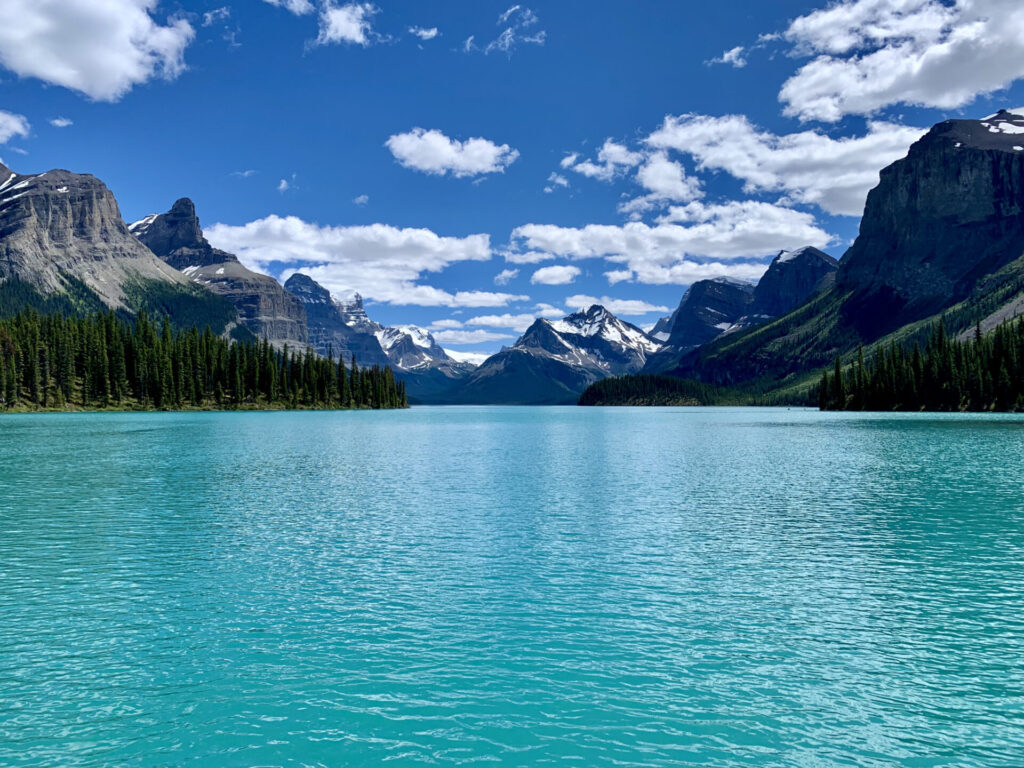
Up the Icefields Parkway you’ll find Jasper National Park which is similar to Banff but has more wildlife and is a little smaller/quieter.
Here are a few tip for Banff backpackers.
Is Banff Good for Backpackers?
Many people wonder if Banff is good for backpackers. The answer is not a simple yes or no.
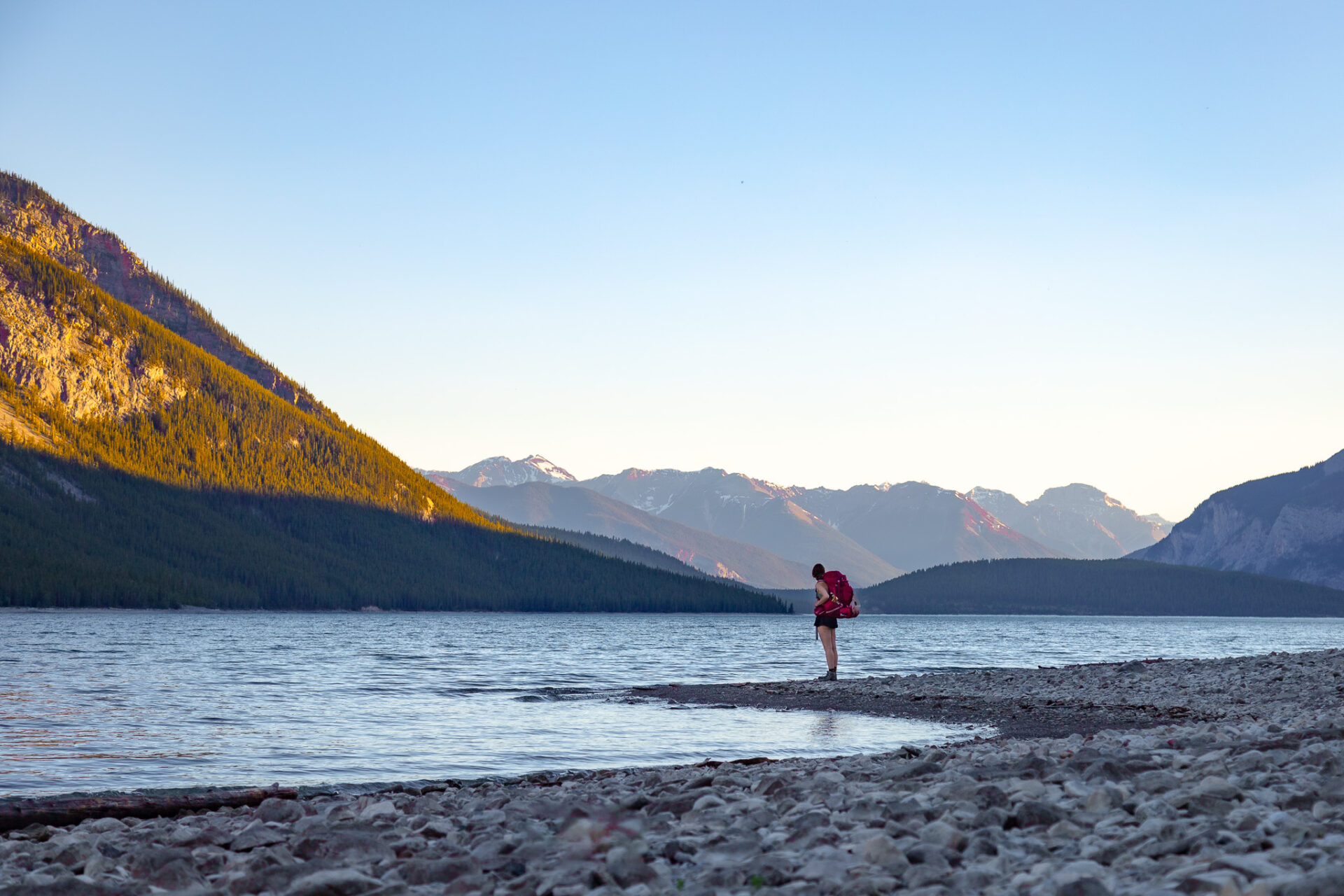
Yes Banff is good for backpackers because there’s multiple hostels in town, great public transportation, and tons of activities. There are free ski shuttles in the winter and there are plenty of rental shops to easily supply you with the gear you need so you don’t have to pack everything.
No Banff is not good for backpackers because it’s expensive, busy, and everything has to be booked far in advance. You cannot travel spontaneously here.
After living here and travelling all over the world, I would personally never travel Banff in typical backpacker fashion as money does not go far here. Living here or travelling with a car and camping is the best way to travel Banff to experience it fully without spending every dollar you’ve saved.
Want to Live in Banff?
For some Banff isn’t a vacation spot, but a home. If you’re looking to escape to the mountains, if you’re wondering what the heck to do with your life, if you want to make some radical life changes, or if you’re looking to have a bunch of fun and meet a bunch of people – moving to Banff may be a great option for you.
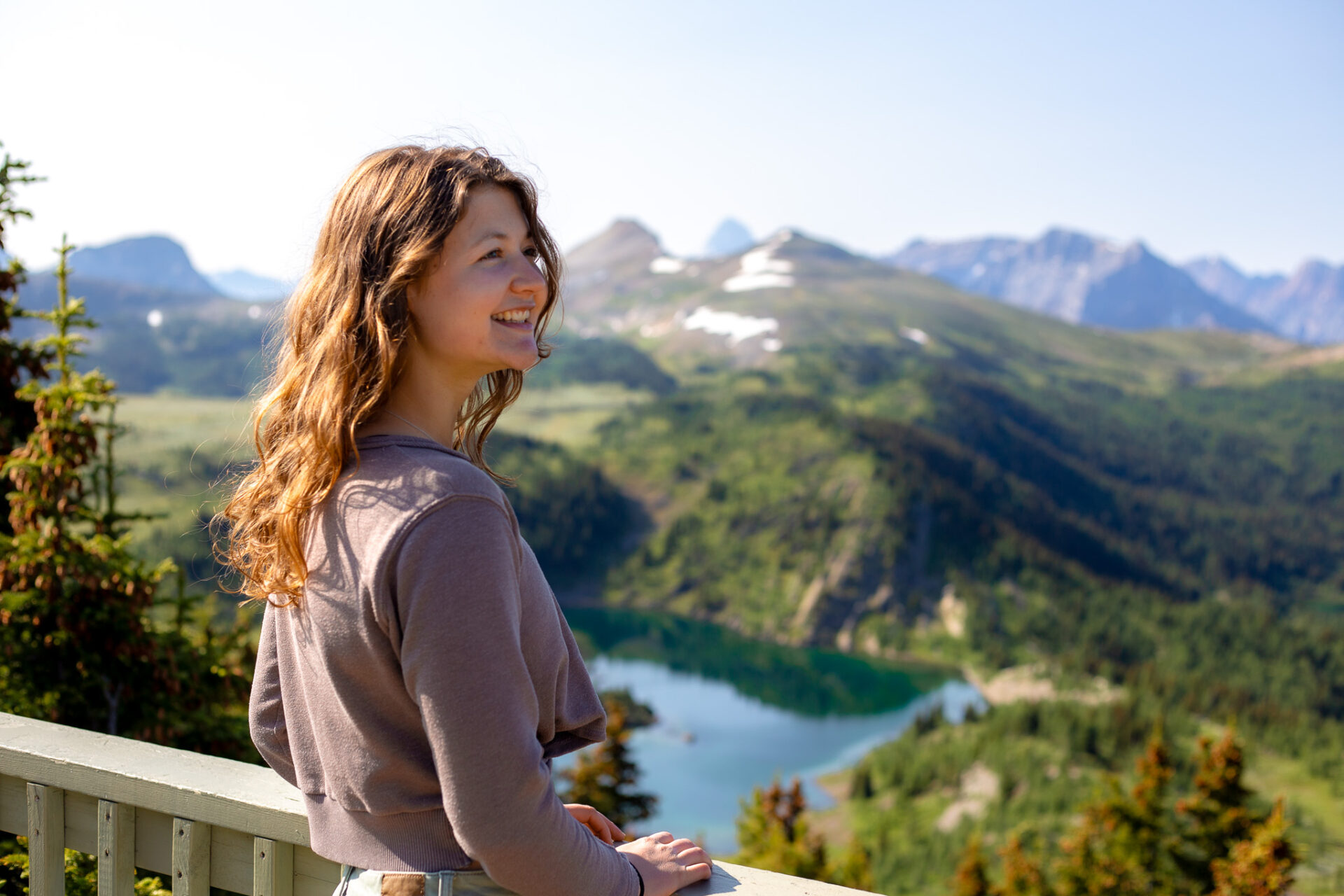
I’ve lived in Banff for years and I always recommend doing at least a summer or a winter season here. in this guide I’ve written about everything you need to know when it comes to living in Banff to make the process a bit easier for you.
and that concludes my post for how to plan a trip to Banff!
I hope this post was valuable to those planning to backpack Banff or to those planning a luxurious getaway to the mountains. If you’re looking to read more of my Banff blogs you can find them all here.
Wondering how to plan a trip to Banff? Here’s everything you need to know.
Banff Google Map: 600+ Pins

Get my 600+ Banff recommendations saved to your Google Maps app
Outdoors: 100+ hiking trails, backcountry campgrounds, ski resorts, waterfalls & lakes
Planning: lodging, restaurants, public washrooms & transit hubs
Things to do: tours, viewpoints & unique activities
I lived in Banff for years and know all the best spots!
How to Plan a Trip to Banff
Happy adventuring!
Taylor ♡
Like This Post?
Share with friends or save it for later!
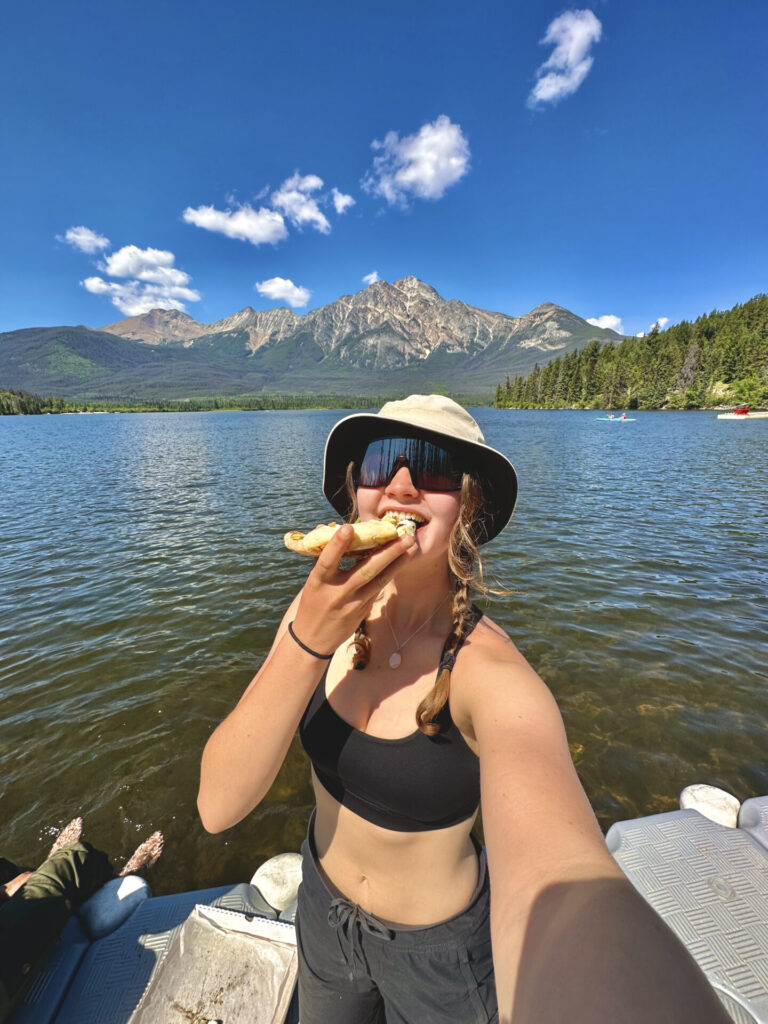
About the Author
HI, I’m Taylor – the voice behind The Holistic Backpacker.
After moving to Banff National Park in 2020 I became an outdoor adventure enthusiast and vowed to never stop exploring.
I now spend my days travelling the world, climbing mountains, and spending nights under the stars in the Canadian Rockies backcountry.
I created The Holistic Backpacker so I could share my adventures and help connect people like you with the same amazing experiences.


